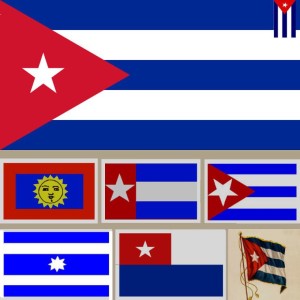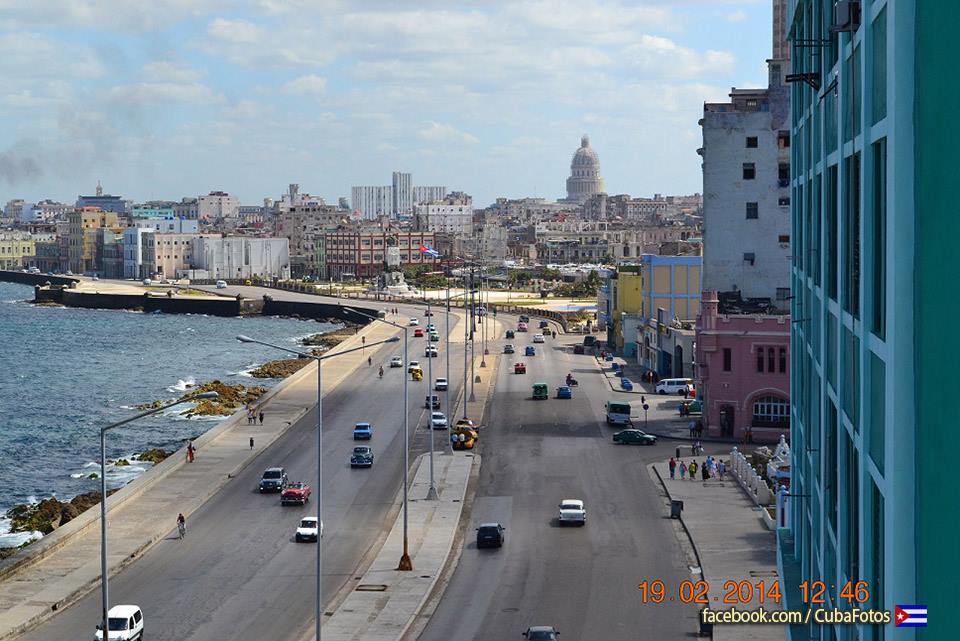THE CUBAN FLAG. OURS SINCE 1850.
The flag of Cuba was proclaimed as such on April 11, 1869, at the Assembly of Guáimaro. This flag was hoisted for the first time in Cuba by General Narciso López Venezuelan born in the city of Cardenas, the May 19, 1850.
The national flag was raised before in the US in Cuba, where Narciso López’s first hoisted in the city of Cardenas, Matanzas province.
It tells the story that was in the US city of New York, the General Narciso López, fighting for the independence struggle of CUBA and tired by his revolutionary chores, he slept in a park in the city. Waking looked at the sky and saw blue and white celajes together with a red spot that produced the setting sun. An oscillating star shone the center. These elements completed a happy idea. Excited went in search of his friend, Miguel Teurbe Toulon (poet, patriot and artist) who with the ideas expressed by Narciso López, designed the Cuban flag, which was manufactured from satin fabric by the cousin and wife of Teurbe: Emilia .
Both the flag as the national shield were created by the same person, Miguel Teurbe Toulon. The design specifications of both were established by Cuba’s first president, Tomás Estrada Palma, by decree, April 21, 1906 and have remained unchanged since then.
Its form is rectangular, longer than wide double, consisting of five horizontal stripes of equal width, three of indigo blue and two white arranged alternately. A red equilateral triangle at one end, one side of which is vertical, occupies the entire height of the flag and constitutes its fixed edge. This triangle has in its center a white five-pointed star, inscribed in an imaginary circle whose diameter is equal to one third of the height of the flag, with one of its faces the upper free edge of the flag points.
Meaning of its elements:
The lone pentagram represents the free, independent and sovereign republic that had to be Cuba and Cuban unity.
Red, located within a triangle alluding to the triptych of the French ideals of liberty, equality and fraternity, refers to the blood of the struggle.
The white stripes purity of ideals and virtue of Cubans.
The blue of the three departments in which it was divided at that time Cuba: West, Central and East.
The original flag created by Narciso López in 1849, was the star with a tip toward the free end of the triangle. The current position of the star was determined by the first constitutional president of CUBA, Don Tomás Estrada Palma, a completed April 21, 1906. Decree So also determined on that blue set for the three stripes, deciding that they were blue turquí.
Other flags waved in our country also, among which we mention that appear from left to right of publication:
1823 Design of Bolivar to La Union de Cuba. Called “Bandera del Sol”
1848 Revolt of Narciso López
1850 The hoisted by Narciso Lopez Cardenas.
1852 Independence.
1868 Flag used by Carlos Manuel de Céspedes, the Father of the Nation, in the levantamiendo “Grito de Yara” on October 10, 1868.
MemoriasDeCuba/Derubin Jacome/IntrnetPhotos/www.thecubanhistory.com
The Cuban History, Hollywood.
Arnoldo Varona, Editor.
LA BANDERA CUBANA. NUESTRA DESDE 1850.
La bandera de Cuba fue proclamada como tal el 11 de abril de 1869, en la Asamblea de Guáimaro. Esta bandera fue enarbolada por primera vez en Cuba por el General de origen venezolano Narciso López en la ciudad de Cárdenas, el 19 de mayo de 1850.
La bandera nacional se izó antes en los EE.UU. que en Cuba, donde Narciso López la izó por primera vez en la ciudad de Cárdenas, provincia de Matanzas.
Cuenta la historia que se encontraba en la ciudad norteamericana de Nueva York, el General Narciso López, luchando por la gesta independentista de CUBA y cansado por sus trajines revolucionarios, se quedó dormido en un parque de dicha ciudad. Al despertarse miró al cielo y vio celajes azules y blancos conjuntamente con una mancha roja que producía el sol poniente. Una oscilante estrella brillaba al centro. Estos elementos completaban una feliz idea. Emocionado fue en busca de su gran amigo, Miguel Teurbe Tolón (poeta, patriota y dibujante) quien con las Ideas manifestadas por Narciso López, diseñó la bandera cubana, la que fue confeccionada en tela de raso por la prima y esposa de Teurbe : Emilia.
Tanto la bandera como el Escudo nacional fueron creados por la misma persona, Miguel Teurbe Tolón. Las especificaciones de diseño de ambos fueron establecidas por el primer presidente de Cuba, Tomás Estrada Palma, mediante Decreto, el 21 de abril de 1906 y han permanecido sin modificaciones desde entonces.
Su forma: Es rectangular, de doble largo que ancho, compuesta por cinco franjas horizontales del mismo ancho, tres de color azul turquí y dos blancas dispuestas de forma alternada. Un triángulo equilátero de color rojo en uno de sus extremos, uno de cuyos lados es vertical, ocupa toda la altura de la bandera y constituye su borde fijo. Dicho triángulo lleva en su centro una estrella blanca de cinco puntas, inscripta en una circunferencia imaginaria, cuyo diámetro es igual a un tercio de la altura de la bandera, con una de sus puntas orientada hacia el borde libre superior de la bandera.
Significado de sus elementos:
La estrella solitaria de cinco puntas representa la república libre, independiente y soberana que debía ser Cuba y a la unidad de los cubanos.
El rojo, ubicado dentro de un triángulo en clara alusión al tríptico de los ideales franceses de: libertad, igualdad y fraternidad, alude a la sangre derramada en la lucha.
Las franjas blancas la pureza de los ideales y la virtud de los cubanos.
Las azules por los tres departamentos en que se dividía en esa época Cuba: Occidente, Centro y Oriente.
La bandera original creada por Narciso López en 1849, tenía la estrella con una punta dirigida hacia el extremo libre del triángulo. La posición actual de la estrella fue determinada por el primer presidente Constitucional de CUBA, Don Tomás Estrada Palma, en un Decreto cursado el 21 de abril de 1906. Así también determinó sobre que azul fijar para las tres franjas, decidiendo que éstas fueran de azul turquí.
Otras banderas también ondearon en nuestro país, entre las que podemos mencionar y que aparecen de izquierda a derecha de la publicación:
1823- Diseño de Bolivar para La Union de Cuba. Llamada “Bandera del Sol”
1848- Revuelta de Narciso López
1850- La enarbolada por Narciso López en Cárdenas.
1852- Independentista.
1868- Bandera usada por Carlos Manuel de Céspedes, El Padre de la Patria, en el levantamiendo “Grito de Yara” el 10 de Octubre de 1868.
MemoriasDeCuba/Derubin Jacome/IntrnetPhotos/www.thecubanhistory.com
The Cuban History, Hollywood.
Arnoldo Varona, Editor.



 THE CUBAN FLAG. OURS SINCE 1850. ** LA BANDERA CUBANA. NUESTRA DESDE 1850.
THE CUBAN FLAG. OURS SINCE 1850. ** LA BANDERA CUBANA. NUESTRA DESDE 1850.
